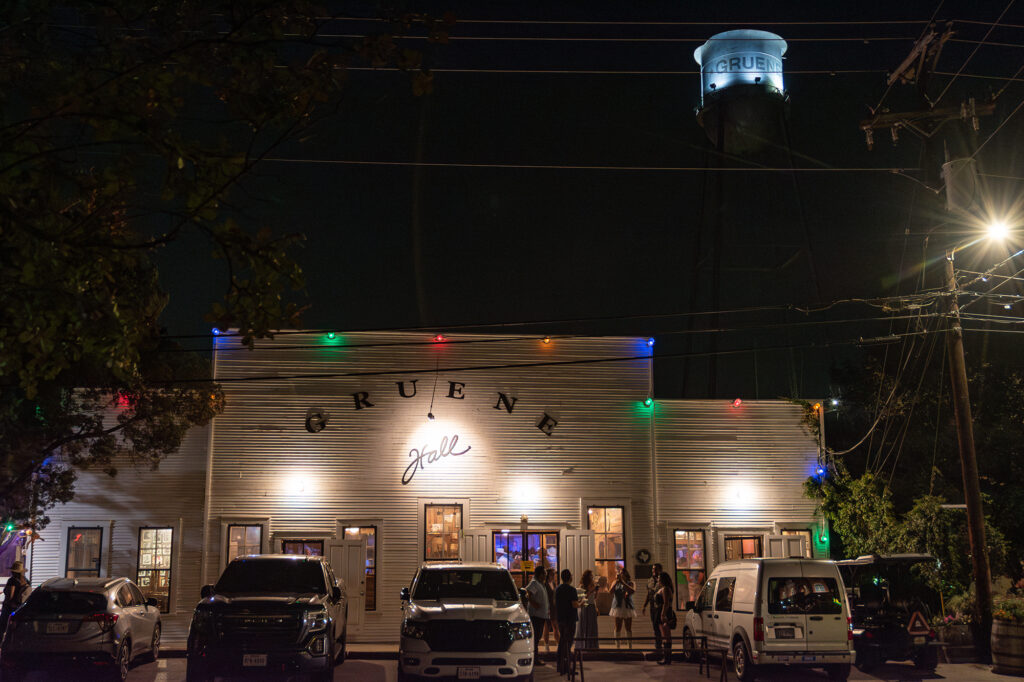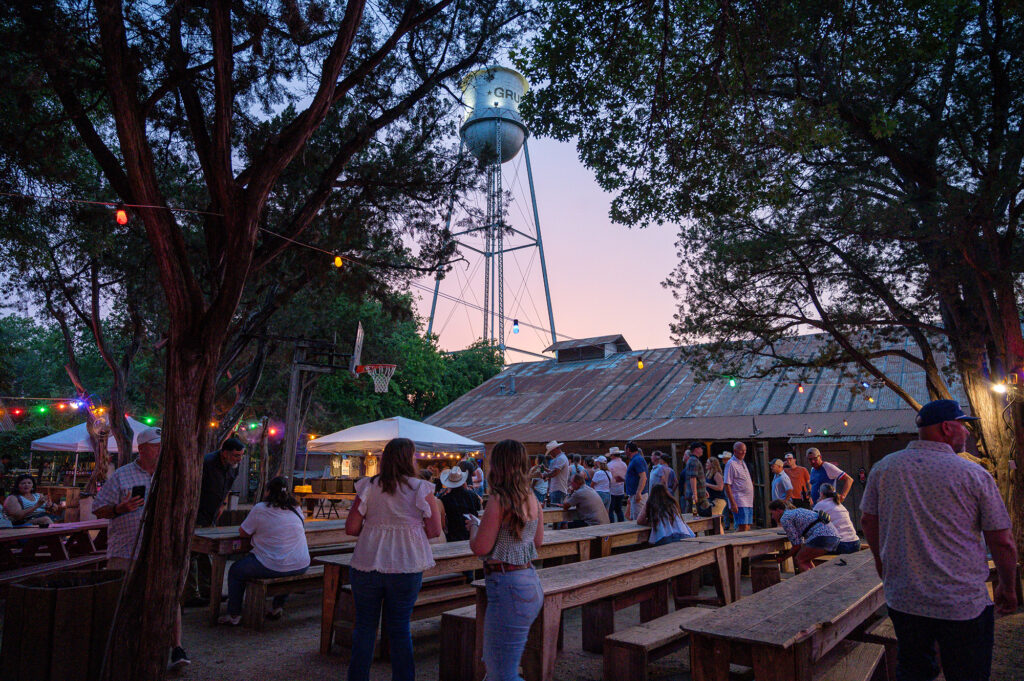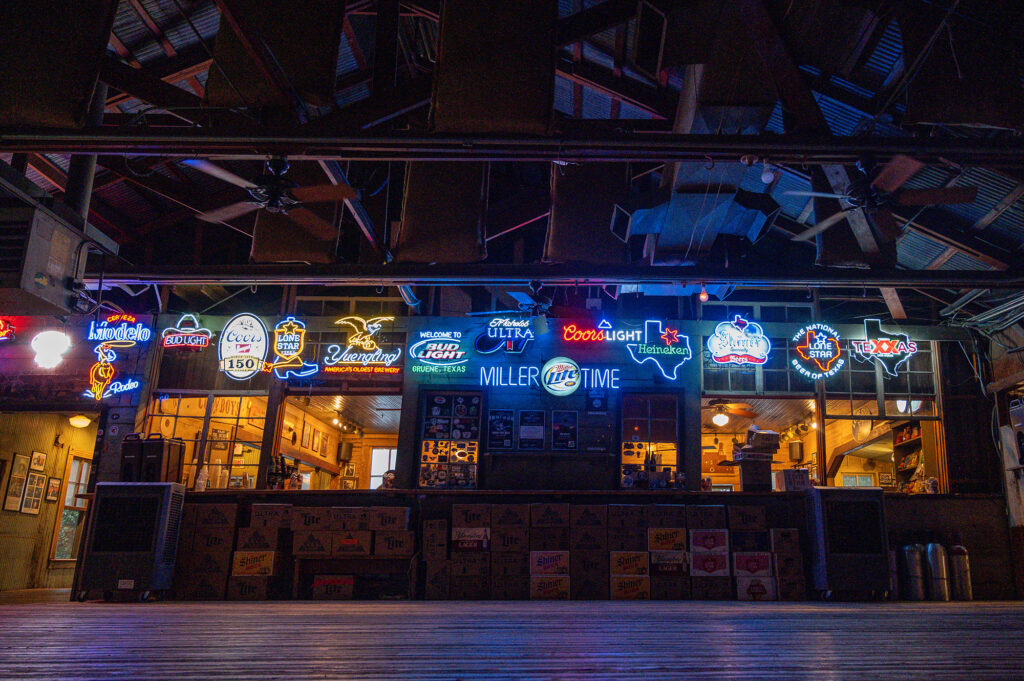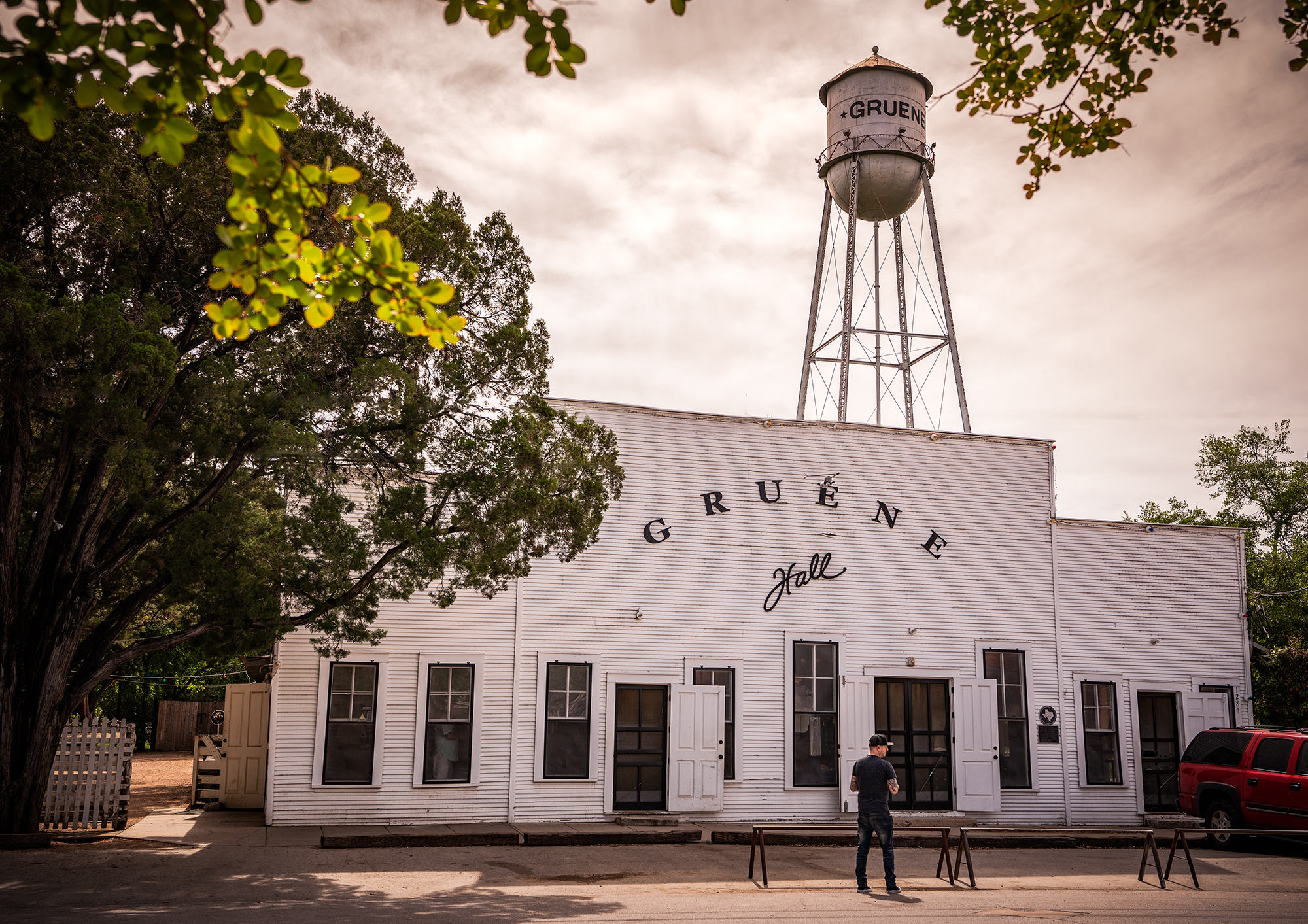Outside of Gruene Hall, cords of rainbow lights hang like candy necklaces over a large, lively beer garden. This year, Texas’ oldest continuously operating dance hall celebrates its fiftieth anniversary under the stewardship of the Molak family, who’ve turned a humble, historic venue into a veritable music landmark.
Despite its unassuming exterior, the story of Gruene Hall is a rich and multi-faceted one that dates to the mid-19th century, when German immigrant farmers settled in Comal County. In 1903, a settlement named Goodwin, located a few miles northeast of New Braunfels, was renamed Gruene thanks to Henry D. Gruene, who established a large cotton farming operation in the late 1870s. He also established a school, a mercantile store, a cotton gin, and a dance hall and saloon, built in 1878 by Christian Herry. By the early 1900s, the town’s commercial development and H.D. Gruene’s cotton empire were thriving, thanks to the completion of passenger and freight depots for both the International-Great Northern and the Missouri—Kansas—Texas railroads. As such, the dance hall became the community’s social hub, home to weddings, funerals, and all-night dances on the weekend, rampant with polka and waltzing.

As time passed, the town declined, due to a Boll Weevil infestation that devasted the cotton crop, along with the onset of the Great Depression and World War Two. Gruene Hall, however, never shuttered.
In 1970, a group of real estate developers bought a tract of the Gruene estate — including all the historic buildings — with plans to destroy them and make way for new condominium developments. Luckily, preservationists reacted, advocating to designate the area a historic district. In 1975, the entirety of Gruene’s Historic District was placed on the National Register of Historic Places, thanks in large part to a UT Austin architecture student named Chip Kaufman, who inventoried the edifices for the Texas Historical Commission and helped find new ownership for the buildings.
Among the first owners was the late San Antonio native and stockbroker, Pat Molak who changed the course of Gruene Hall’s future. Back then, Gruene consisted of only a few dusty roads and a cluster of late 19th and early 20th century Victorian houses and colonial structures in need of repair. Still, Molak — known to many as “Mo” — had a gut feeling about the hall. After graduating from UT-Austin and noticing the live music scene emerging there, not to mention the burgeoning collegiate community in San Marcos, he sensed a ripe opportunity to create something special.
“A friend told him about this beer joint,” recalled Susie Molak, Pat’s wife. “He’d looked at a couple of other little dance halls, but he saw the potential in this one.”
Ultimately, Molak’s purchase, and early vision, proved visionary indeed. Over the course of five decades, with the help of his friend, Mary Jane Nalley, he not only preserved and revived the old dance hall, but expanded to neighboring structures too, while turning the community into a vibrant destination beloved across the state.
“I think my dad’s authentic hospitality combined with the history and the magic that were already there created this setting people kept coming back to,” said Pat and Susie’s daughter, Katie Courtney, who serves as both a Board Member and Managing Director of the Molak Corporation.

Today, visitors to Historic Gruene will feel the Molak’s magic at every turn thanks to their impressive business portfolio. Aside from Gruene Hall, the family owns and operates numerous establishments, from its casual eatery, Mozie’s, to a souvenir shop called Cotton Eyed Joe’s, plus The Grapevine wine bar, and The Gristmill, to name a few. The latter operates from the ruins of the old cotton gin overlooking the Guadalupe River, luring guests of all ages with its savory onion rings and sizzling chicken fried steaks.
“Everything was kind of piecemealed together,” Katie said of the growing nature of their business, which includes other real estate properties in San Antonio and several lease tenants in Gruene, such as the popular Gruene Hat & Boot Company and the Gruene General Store.
Undoubtedly, theirs is a success story that’s been built with good, old fashioned hard work. “He started with very little money, standing behind the bar, and figuring out how to pay for beer the next day,” Susie explained of her husband in the early days. “Once he began accumulating enough, he would buy other buildings.”
Particularly in summer, the community comes alive as folks venture in from floating on the river to dance with family and friends on the scuffed and sacred floors of Gruene Hall. Seven days a week, live music plays within the Registered Texas Historic Landmark, which still retains its original rusted roof and screen-flapped walls.
Despite its unassuming exterior, it is here, in this humble, open-aired venue, that many of the most well-known entertainers of country and Americana music launched their careers years ago — including the ‘King of Country’ himself.
George Straight was one of several young artists to stumble in in the late seventies, along with Willie Nelson, Jerry Jeff Walker, Lyle Lovett, Robert Earl Keen, and Hal Ketchum. Visitors to the beer garden can still find many of the picnic tables made by Ketchum — a former carpenter — some of which are scrawled with names of tourists and crooners passing through. “It just started accumulating locals,” Susie said, plainly. “All these up-and-coming artists wanted a place to play.”
Since getting its start in Americana, country, and Texas outlaw music, Gruene Hall has widened its net, welcoming everyone from Chris Isaac to Kevin Costner, LeAnn Rimes, Billy Bob Thornton, and Little Richard. Regardless of the musical genre, it’s the hall’s familiar, unchanging nature — not to mention its intimate environs — that has solidified its appeal.
“Having these guys play here and you’re just this far from them…” Susie said, motioning her hand in front of her face. “For the entertainers too, they’re watching people mouth every word they sing, and you just don’t get that in a big venue.”
Walking into the 6,000-square-foot landmark today feels like stepping back in time. In the bar, a large sign beaming ‘Welcome Cowboys’ hangs next to battered hats, weathered signs, black and white photographs, and a rattlesnake skin mounted on wood. Plastic pitchers covered in stickers collect tips on the bar, while framed pictures and memorabilia cover the Pat Molak Legacy Wall.
The newly minted space, unveiled in June, commemorates the incredible impact of Pat Molak, who passed away in 2024 at the age of seventy-six. The legacy wall also features never-before-seen collectables allocated from the hall’s most iconic artists over the last five decades.
Today, the memories made together in Gruene are a salve for the Molak family. As a young girl, Katie can remember meeting John Travolta at Gruene Hall during the filming of a dance scene in Nora Ephron’s film, Michael. More recently, a two-stepping competition for the TV sitcom, The Bachelorette, was filmed at the venue. “I think one of my favorite memories was when Garth Brooks came back,” she said, smiling. “They closed the streets and put big screens out, and it was crazy to have him play for only eight-hundred people.” Another poignant moment came about last December during the holiday season. “Every year, they do a town lighting here,” Katie said, wistfully. “I can remember pulling the big switch, and my kids did it this year.”

Much like the Molak’s — and the German immigrants who settled here well over a century ago — Gruene Hall has fostered a generational quality, gathering people together to celebrate the cadence and rhythms of daily life. “There are so many core memories you see when you’re out there, whether it’s people on their bachelorette party, getting engaged, or coming from Austin or San Antonio for Mother’s Day … you always see celebrations,” Katie shared. The family hosted a celebration of life there for their beloved patriarch last year, while others such as Nolan Ryan have rung in their fiftieth birthdays in this treasured, time-worn venue.
This summer through year’s end, the Molak Corporation has a variety of commemorative anniversary plans in store, from ticket giveaways to concerts, and photo contests. “One thing we’re really hoping is to become more of a family destination,” Katie said. “Kids have always gone to The Gristmill, but historically there’s not been a ton to do other than go to the Gruene General Store, get candy, dance…”
To remedy that, last winter, they installed an ice rink in the green space neighboring the historic mercantile building. Today, it has been transformed into a one-of-a-kind mini golf course with carefully crafted holes inspired by the Gruene Water Tower, Gruene Hall, and musical instruments. They’re also continuing a Two Ton Tuesday swing lesson and dancing night, popular with the local New Braunfels youth, while introducing a new series called Honky Tonk Thursdays in partnership with The Sims Foundation. The latter initiative is a return to the hall’s early roots spent incubating bands and giving them a pathway to the future. This summer, the Gruene Antique Company will close, making way for an old school mercantile business opening later this year.
In many ways, Gruene Hall today is a continuation of its late 19th century origins, when open air polka dancing and celebrations of all kinds took place under its roof. Not much has changed of the original design, save for a refreshment of the stage backdrop, with its pastoral views cloaked in violet drapes.
“Occasionally we take the dust off the walls, and even that’s a conversation,” quipped Anna Tauzin, the Molak Corporation’s Chief Marketing Officer. Perhaps Pat Molak said it best with his motto, “gently resisting change,” that’s emblazoned on Gruene Hall shirts across town.
After fifty years of stewardship, the Molak family trudges forward with both gratitude for the past and an awareness for the future of the responsibility in preserving such a prized piece of Texas history. “My Dad was the culture and the CEO, CFO, there were no titles … everything lived in his head, so it’s been this interesting transition since he passed of trying to discover what those processes were, and put them down on paper,” Katie shared. “We all want to continue growing this in the right ways, adhering to the legacy he created — and keeping it in the family for the next generation.”


